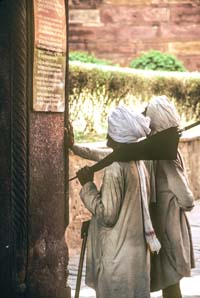 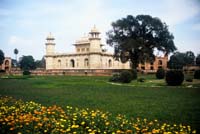 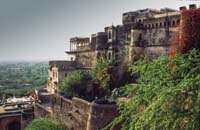 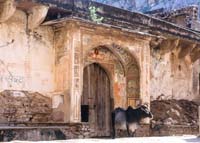 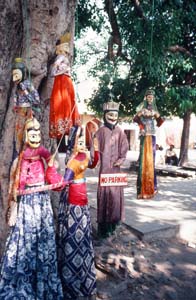 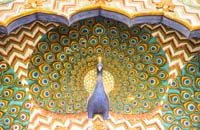 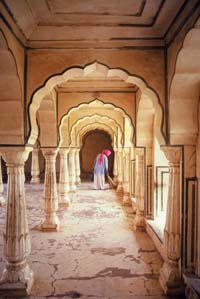 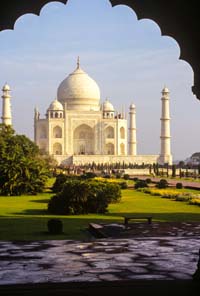 |
Seven days from Delhi Golden Triangle After spending some time in Delhi (see the “Four Days in Delhi” itinerary if you need some suggestions) set off to see the heart of northern India, usually called “The Golden Triangle”. DAY 1: Delhi to Agra. This is usually about a 3 hour drive (205 km), but there are a couple of possible stops along the way. Mathura is one of Hinduism’s seven sacred cities, as it is the birthplace of Lord Krishna. Nearby Vrindavan, where Krishna spent his childhood, is a very important pilgrimage site and is wonderful to visit. A little further on, is Sikandra, Emperor Akbar’s tomb. It’s worth a stop if you are a history buff, but there will be more beautiful tombs ahead. Just letting you know. When you arrive in Agra, you may want to dash off to the Taj for sunset. In spite of the horrific ticket price, you will probably want 2 visits here to see it in different light. Day 2: In Agra. Perhaps an early morning return to the Taj? It opens at sunrise. Take some time to wander around the gardens, known as a ‘Char-Bagh” – a garden with a four course waterway. Afterwards, you might want to do some sightseeing on the other side of the Yamuna River. It was here that Shah Jahan had intended to build his black marble tomb to compliment that of Mumtaz Mahal’s, and there are nice vistas of the Taj across the (seasonal!) water. The tomb of Itimad-ud-Daulah is one of my favorite places. Its beautiful as well as quiet and peaceful. Built ten years before the Taj, it incorporates many of the Persian design elements which find their glory in the Taj Mahal. is the first example, in Undia, of the pietra dura inlay style. Neaby is a dilapidated but evocative tomb of Afzal Khan called Chini Ka Rauza. Also nearby is one of the oldest Char-Baghs in India, the Rambagh, built by Babur. After lunch, you might want to explore the enormous Agra Red Fort, seat of the government during the reigns of Akbar, Jahangir, and Shah Jahan. Literally a city within a city, its size and ostentation was intended to affirm the power and glory of the great Mogul empire. Shah Jahan died here, a prisoner of his son, and we can visit his quarters where he spent his last years gazing wistfully out at the tomb of his beloved Mumtaz Mahal. Day 3: Agra to Jaipur via Fatehpur Sikri The drive to Jaipur is about 4 hours (245km) but along the way, you can stop at Fatehpur Sikri, the haunting red sandstone city built by the Mogul emperor Akbar in 1569 to house some 200,000 people. Intended to be his new imperial capital, this regal ghost town is an exquisitely preserved example of the best of princely opulence. Palaces, mosques, huge bathing pools, and stables for his 30,000 horses were built out of carved red sandstone, used for thirteen years and then abandoned when the court moved back to Agra. Depending on the time, you may want to stop off at the Keoladeo Bird Sanctuary. The only problem is that you will be mid-day and the bird watching is best in the mornings and evenings. Or, decide to spend the night here! Day 4: In Jaipur Set out first thing this morning for the Amber Palace, the first capital of the Kuchwaha clan of Rajputs who began building in this area in about 1040 AD. The Amber Fort was begun in about 1600 and then abandoned in 1727 when Jai Singh moved the capital to Jaipur. Access to the fort is by traditional Maharaja style transport, sitting atop brightly painted and caparisoned elephants who lumber up the massive ramparts and through the enormous gates. This fort is very “touristy”, but fortunately many of the tourists that you’ll meet are Indian who afford us a wonderful opportunity to see history through their eyes. The Hawa Mahal, the “Palace of the Winds”, is one of India’s most notable and most photographed sights. From the street, it looks like just another beautiful palace, but from the side, we find that it is just a facade where the women of the harem could sit to watch the life go by. The City Palace is behind all this – see if the guards will allow you to go in through the women’s walkways between the zenana and the Hawa Mahal. The palace is very nice and has an interesting museum, but its claim to fame are the four painted doorways to the main courtyard that have become symbols of Jaipur. If you’re not going to get to either Jodhpur or Bikaner, this is your best bet for a colorful and no-too-touristy bazaar. There are several, depending on what you’re looking for. It would really be nice to have a local guide for all this, but beware of the kids standing around on the street. In the evening, it is possible to attend a (touristy but interesting) dinner and cultural show at the beautiful hilltop Amer Fort. Day 5: Jaipur to Samode If you are a photographer, you might want to return to the Hawa Mahal for morning light. Finish up any leftover sightseeing and then drive an hour north to Samode. This delightful walled village is medieval India at its best. Set away from the main road, it is totally untouched by the hullabaloo (did you know this is an Indian word?) that characterizes most Indian towns. Old stone houses, an ancient deserted hilltop fort and huge trees make this one of the most peaceful and enchanting settings in Rajasthan. Samode also carries some kind of magical photographic charm. Many India travelers report that their best pictures come form this little place. Take the afternoon to explore the town, take a camel ride, or just relax around the amazing hotel. The Samode Palace Hotel here is a must and if you have been saving up to splurge on an upgraded room, the Maharaja Suite here is a good option. It’s not drippingly opulent like the Rambagh Palace, but it’s definitely fun. Day 6: Samode to Neemrana It will be about a 4 hour drive to the amazing Neemrana Fort Palace Hotel. This classic Rajput palace/fortress spills down a hill in the middle of the countryside. Spend the afternoon looking around or hanging out in their swimming pool. Day 7: Return to Delhi Depending on where in Delhi you are going – and the traffic, you should be able to drive back in about 3 hours. Even shorter if you are going to Indira Gandhi Airport |
